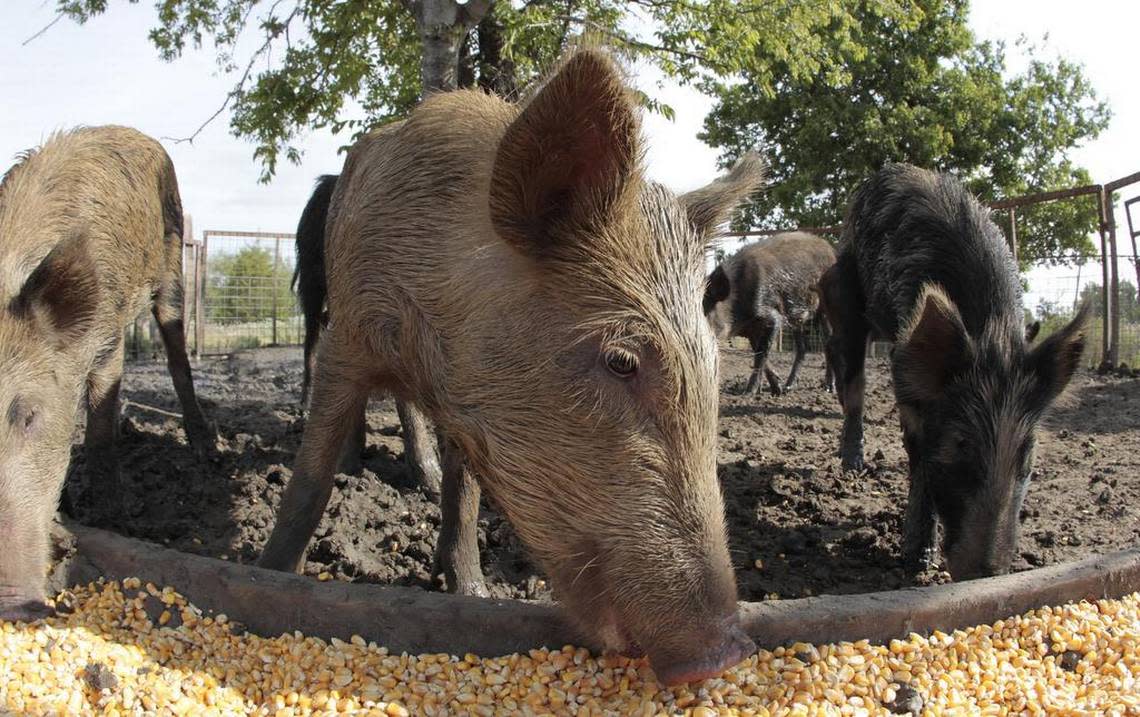Destructive feral hogs have been spotted in Illinois, but experts urge not to shoot them

More than 6 million feral swine are present in the U.S. across 35 states, according to the U.S. Department of Agriculture, and Illinois officials investigated more than 30 reported spottings in the state last year.
Only a fraction of feral swine reports in Illinois turn out to really be the invasive hog, but members of the species have been seen in the Land of Lincoln in recent years.
“They are one of the most destructive possible invasive species we could get,” Peggy Doty, natural resources, environment and energy educator with the University of Illinois Extension, told the News-Democrat.
Feral swine, also referred to as feral pigs, feral hogs, wild boar and razorbacks, weigh an average of 75 pounds to 250 pounds as adults, though some can reach closer to 500 pounds.
One of the reasons feral swine are dangerous is their opportunistic nature. They’re omnivorous and will eat practically anything, and their rooting and wallowing can destroy agriculture and habitats for endangered species in Illinois.
A small group of feral swine can completely annihilate a habitat overnight, Doty said, and they can create food shortages for native species.
The invasive species also poses a threat to human health and the economy in Illinois, as they can carry more than 30 different types of disease and 30 parasites. They can transmit leptospirosis, salmonella, trichinosis and brucellosis to humans, and diseases can affect pets and livestock, too.
“They could be pretty devastating to our pork production in Illinois,” Doty said.
Feral swine can also degrade water quality, according to Bradley Wilson, feral swine coordinator for U.S. Department of Agriculture Wildlife Services in Illinois, and they can live and thrive in pretty much any area that has a water source.
“They are a very harmful and destructive invasive species,” Wilson said. “Their geographic range is rapidly expanding and populations are increasing across the nation.”
Where have feral swine been reported in Illinois?
Illinois does not have and has not had a permanent feral swine population, Doty said. Isolating sightings have been reported, though, and the Illinois Department of Natural Resources reports two self-sustaining breeding populations have been identified in the state.
“On average I would say we receive about 40 reports of feral swine each year, but only a tiny fraction of those are actually truly feral swine,” Wilson said.
Out of 31 reports of feral swine in Illinois in 2022, many involved what were actually loose domestic pigs or pets, Wilson said.
Three of the reports pertained to an adult boar in the Shawnee National Forest area in Pope County, and one was about an adult boar IDNR had been tracking in the Jackson County/Union County area.
Officials with the USDA and IDNR investigate and track reports of feral swine, and those that turn out to be loose domestics are often handled by local animal control departments.
Feral swine usually begin as dumped pets, free-range livestock or pigs released for sport hunting, the USDA reports. While there is a trend on YouTube to corral feral swine from other states to shoot in Illinois, it is illegal to transport the animals, release them or hunt them in an enclosure in the state, according to IDNR.
People lawfully hunting in deer season with a license can shoot feral swine they find in the wild, but many experts say it’s not a good idea.
“The one thing you don’t want to do is shoot them, because they’re so smart,” Doty said.
The reason you shouldn’t shoot a feral hog is because you’ll only get one out of the herd, Doty continued, and the rest will learn to avoid bait and humans even more than they do naturally. The group will instead scatter and reproduce, furthering its population.
Under ideal conditions, an adult sow can produce up to 20 piglets each year. Female juvenile pigs can begin reproducing as young as 6 months old, Doty said, and the species has the greatest reproduction rate potential of any large mammal.
Feral hogs: A growing US problem
Feral hog populations have been established in more than 30 Missouri counties, according to the Missouri Department of Natural Resources.
Texas is the most affected state in the country by feral swine, according to Captain Experiences, a website for hunting and fishing trip bookings. Georgia, Florida, Mississippi and other states also have high volumes of feral swine reports.
If you happen to stumble upon a feral hog in Illinois, or you see signs of rooting and wallowing, officials ask you to report it immediately.
“It’s just such a threat environmentally and agriculturally, we just can’t let them take hold here,” Doty said.
You can report suspected feral swine to the USDA Wildlife Services Illinois State Office at 217-241-6700. In Missouri, you can make reports to 573-522-4115, ext. 3296 or online.
